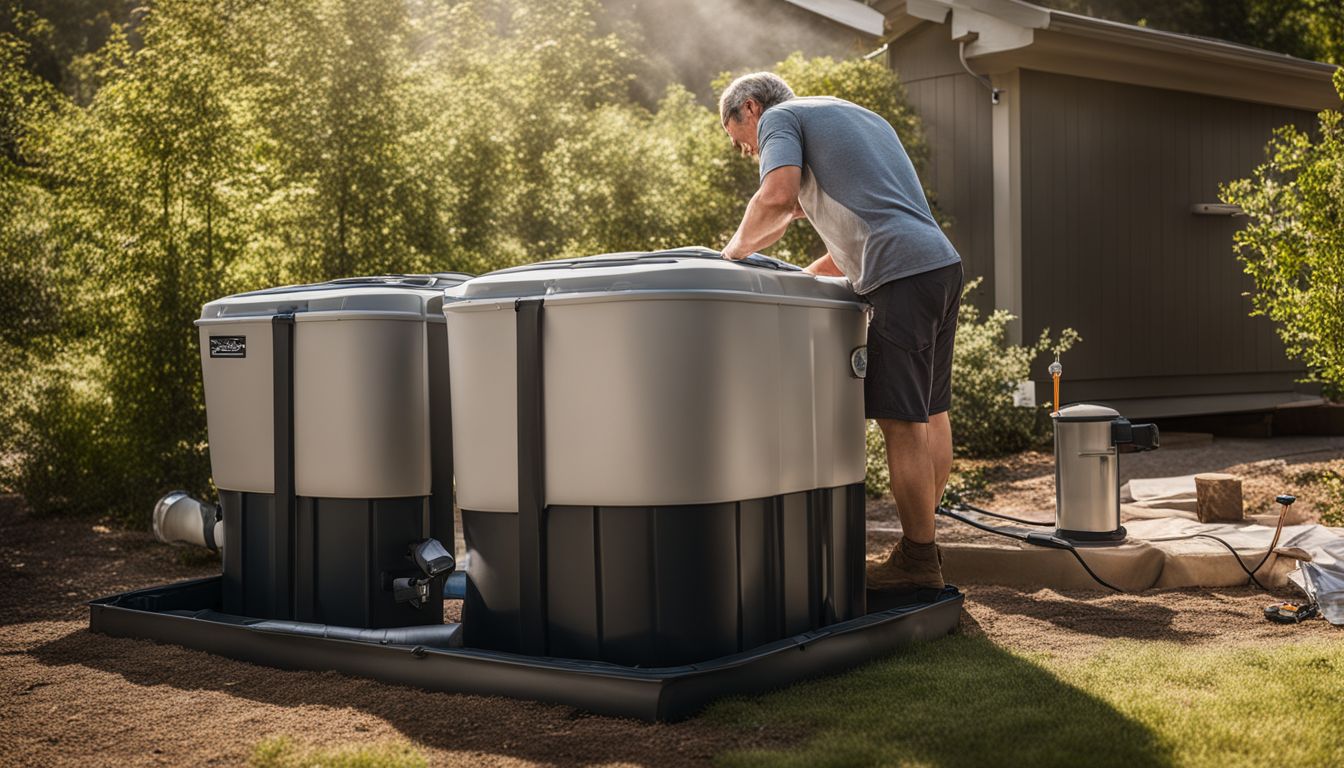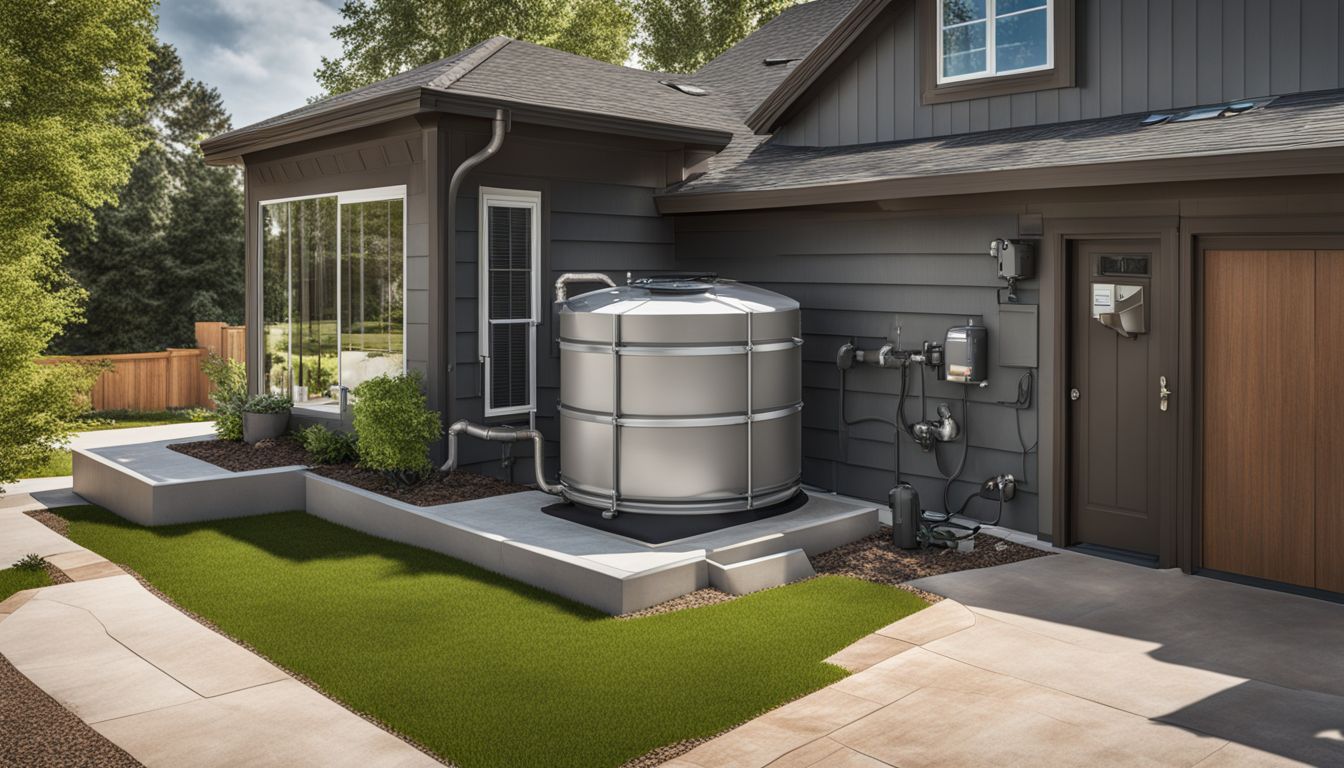
By: Alternative Habitat Blueprint
How to Get a Rainwater Harvest System Approved: Essential Tips from the Department of Energy
Rainwater harvesting seems complex at first glance. It’s about capturing rain from your roof and using it for things like watering plants or flushing toilets. This method has a key benefit – it can lessen the amount of storm water that causes floods and lower some utility bills for managing storm water.
With over 20 years in eco-friendly housing design, I’ve integrated systems that collect and use rainwater in many projects. This experience has shown me not just the environmental benefits, but also how to navigate the often tricky approval process.
In this article, you’ll learn what makes up a rainwater harvesting setup, including parts like gutters and storage tanks, and how you can get yours approved. We’ll cover understanding local rules, getting the right training, and other steps to make your project successful.
Ready to find out more? Keep reading.
Key Takeaways
- Check local rules before you start collecting rainwater. Every place has different laws.
- Get trained and certified in rainwater harvesting to make your project go smoothly.
- Use a calculator from Colorado State University to decide how big your water tank should be.
- Keep your system working well by cleaning and checking it often.
- Know all the parts of a rainwater harvesting system, like gutters, filters, tanks, and pumps.
Essential Elements of a Rainwater Harvesting System

A rainwater harvesting system includes different components, such as gutters and downspouts to collect water from the rooftop. The system also requires storage tanks or cisterns and a filtration mechanism for clean water usage.
System Components
Harvesting rainwater is like collecting nature’s gift. You save water and help our planet. Let’s explore the parts of a rainwater harvesting system.
First, you need a way to collect water, like gutters on your roof. This is where rainwater starts its journey. Next, an inlet filter keeps leaves and bugs out, ensuring only clean water gets collected.
A first flush diverter then takes over. It throws away the first dirty water from each rainfall. The clean water goes into a storage tank for later use.
Overflow mechanisms are key. They direct extra water away from the tank during heavy rains, preventing spills or damage.
Controls make everything work together smoothly. They decide when to store water and when to stop.
For cleaning the stored water, we add a treatment system. It makes sure your water is clean enough for your chosen use, like watering plants or washing cars.
Pumps move the water out of the tank when you need it. They can be simple hand pumps or more advanced electric ones.
Backflow prevention stops dirty water from flowing back into your clean supply.
Flow meters tell you how much water you’re using, helping manage your resources better.
Lastly, a power supply and water level indicator make sure everything runs without hassle and you know how much water you have left.
During my projects, ensuring these components worked together was crucial for client satisfaction and sustainability goals.
With all these pieces in place, managing operation and maintenance becomes much easier.
System Sizing
After talking about the necessary parts of a rainwater collection setup, we now focus on how big your storage should be. This part is key if you want to make sure your system meets your water needs without wasting resources.
You start by figuring out how much rain falls in your area and then guess how much water you’ll use. These steps help you choose a tank that’s just right—not too big or too small.
From my own work with eco-housing projects, I’ve learned this is where most people need help. To get it right, use a rainwater harvesting calculator—Colorado State University offers one that’s easy to use.
It considers local rainfall data and helps estimate the ideal size for your storage unit based on potential catchment area and usage demands. Remember, choosing the correct size for your tank ensures efficient water use throughout the year for things like irrigation or even non-potable indoor uses, making every drop count towards sustainable living.
Operation and Maintenance
Operation and maintenance of a rainwater harvesting system require regular attention. This makes sure your system works well and lasts a long time.
- Clean roofs and gutter–After storms or dry spells, remove leaves and debris. This keeps water clean and flowing right.
- Check the tank–Look for cracks or leaks often. Sometimes you must get rid of sediment at the bottom to keep water fresh.
- Maintain pumps–Make sure they work without too much shaking, noise, or heat. Pumps help move water where it’s needed.
- Test backflow preventers–A pro should check these yearly to stop dirty water from mixing with your clean water.
- Water tests are a must–A qualified person must check the water often to make sure it’s safe, especially if you drink it. They look at cloudiness, pH levels, temperature, and cleanliness.
- Pay attention to how much you store–Make sure your tanks have enough room for all the rain you collect but don’t go over what’s legal in your area.
- Look after your equipment–Replace parts like filters and UV lights as needed to keep everything running smoothly.
- Learn about your system–Know how it works so you can spot problems early and fix them fast.
- Follow local rules–Stay up-to-date with laws to avoid fines or having to make big changes later on.
- Make a maintenance schedule–Write down when to do each task so nothing gets missed.
Keeping up with these tasks will help you use rainwater safely for years.
Navigating the Approval Process

Understanding local regulations is crucial before installing a rainwater harvesting system. Seeking certification in rainwater harvesting training can streamline the approval process.
Understanding Local Regulations
Local regulations for rainwater collection vary by county, with some restrict usage as a potable water source due to potential contaminants. In most areas, using collected rainwater on the same property where it’s gathered is allowed without a water right permit if existing water rights are not affected.
Understanding local regulations is crucial for successful implementation of rainwater harvesting systems.
Rainwater Harvesting Training and Certification
Understanding Local Regulations is essential before embarking on Rainwater Harvesting Training and Certification. Here’s a detailed guide to help you navigate this crucial aspect:
- ARCSA’s Rainwater Harvesting Master program offers training to become an Accredited Professional in the industry – a vital step for gaining expertise in designing and constructing rainwater collection systems.
- The program entails specific prerequisites and a significant commitment to education, ensuring that you gain the necessary knowledge and practical experience needed for certification.
- Courses cover topics such as system components, water quality, beneficial use of harvested rainwater, rooftop precipitation collection permits, and federal energy management programs.
- Understanding local regulations regarding rainwater harvesting is emphasized to ensure compliance with regional laws and legislation.
- The training also provides insights into obtaining permits, navigating the approval process, and maintaining the system in accordance with environmental guidelines.
- By obtaining certification, individuals can enhance their skills in rainwater harvesting, contributing to sustainable water conservation efforts within the alternative house design realm.
By acquiring proper training and certification in rainwater harvesting, you can ensure compliance with local regulations and gain valuable expertise in sustainable water conservation practices for alternative house designs.
Conclusion
In conclusion, getting approval for a rainwater harvesting system involves understanding local regulations and obtaining necessary permits. It’s essential to consider the system components, sizing, and operation for a successful setup.
Regular maintenance is crucial to ensure efficient water collection and use. To navigate the approval process with ease, seek information from relevant government agencies such as the Department of Energy.
By following these essential tips and staying informed about rainwater harvesting practices, you can create an eco-friendly water system that positively impacts your living space.